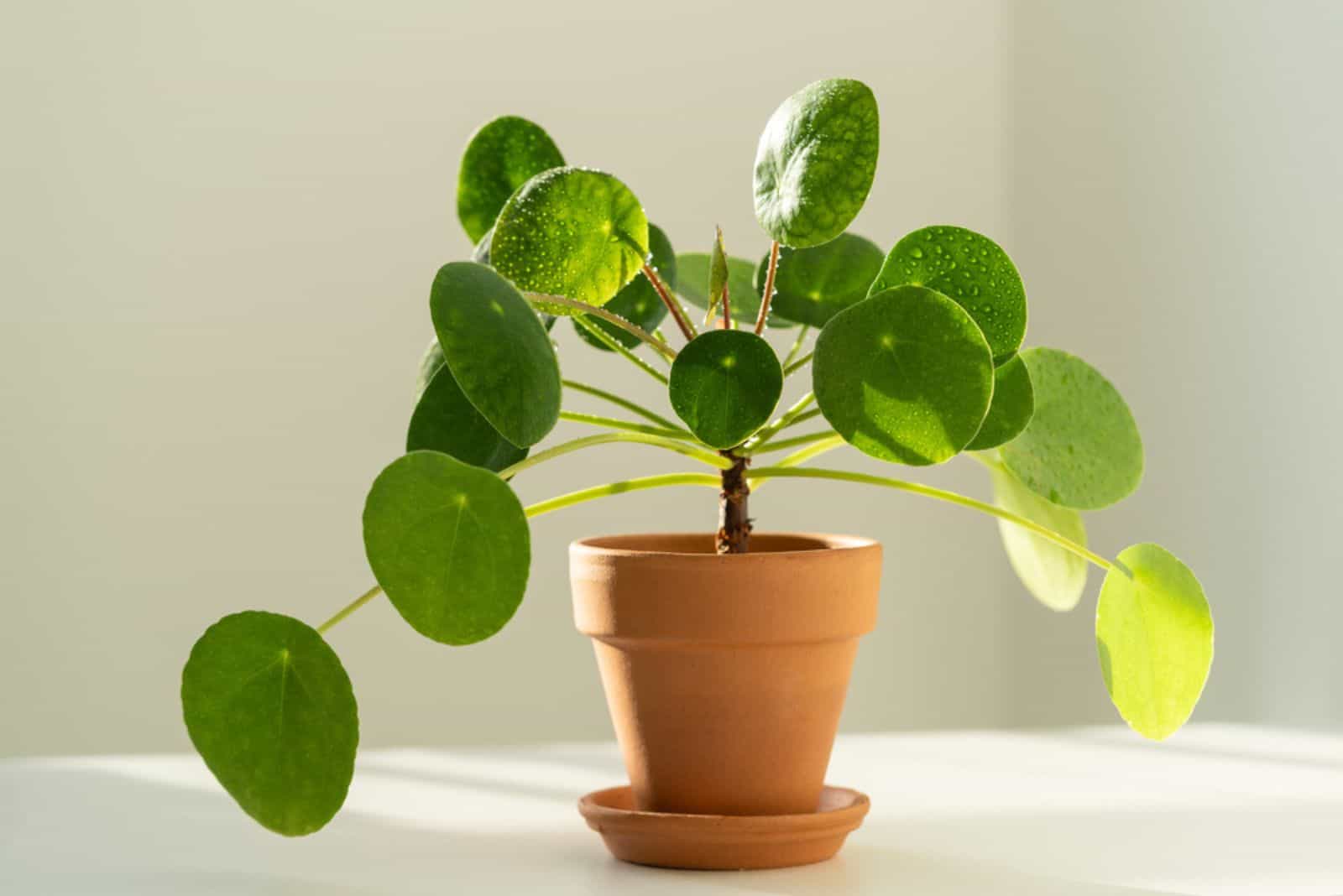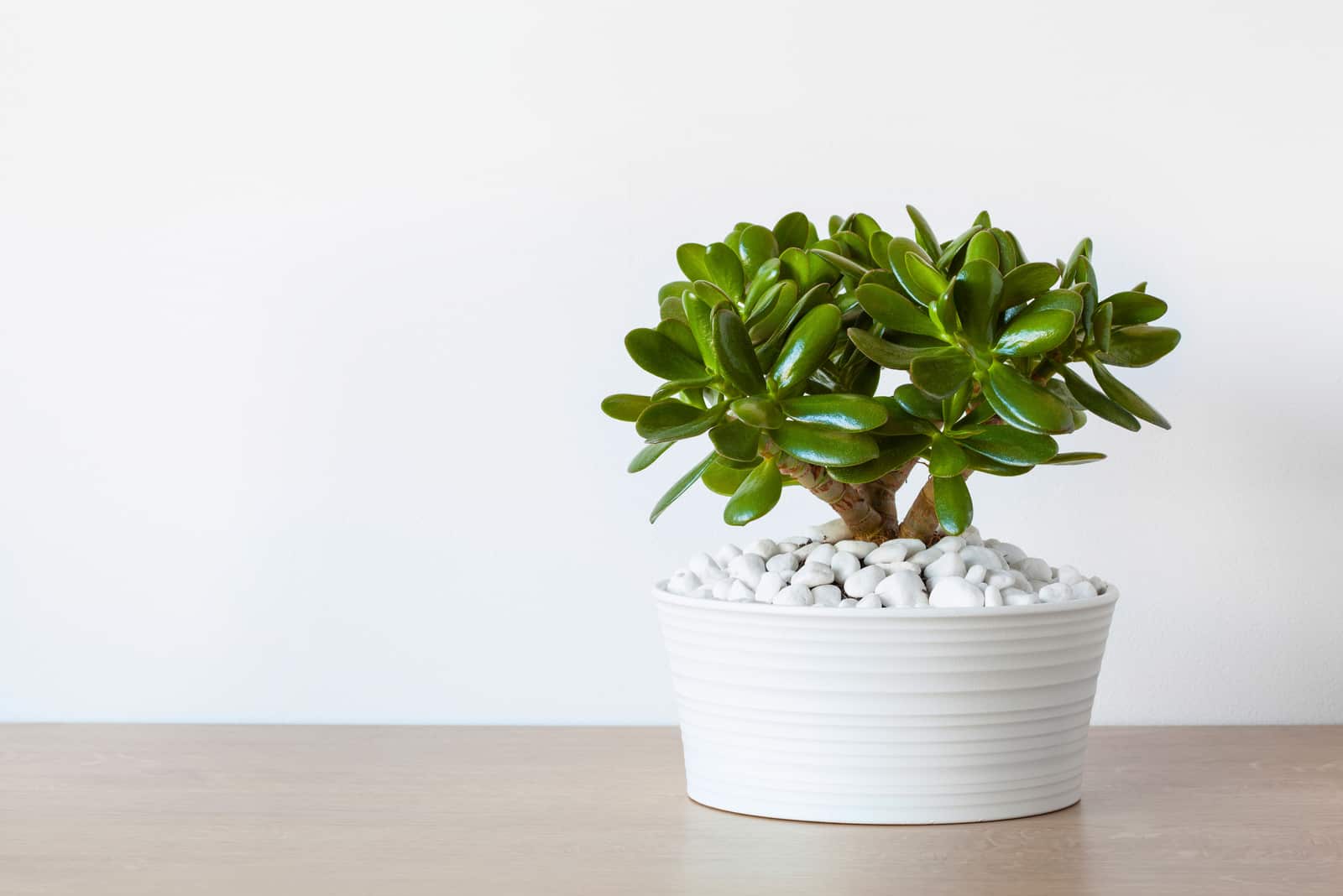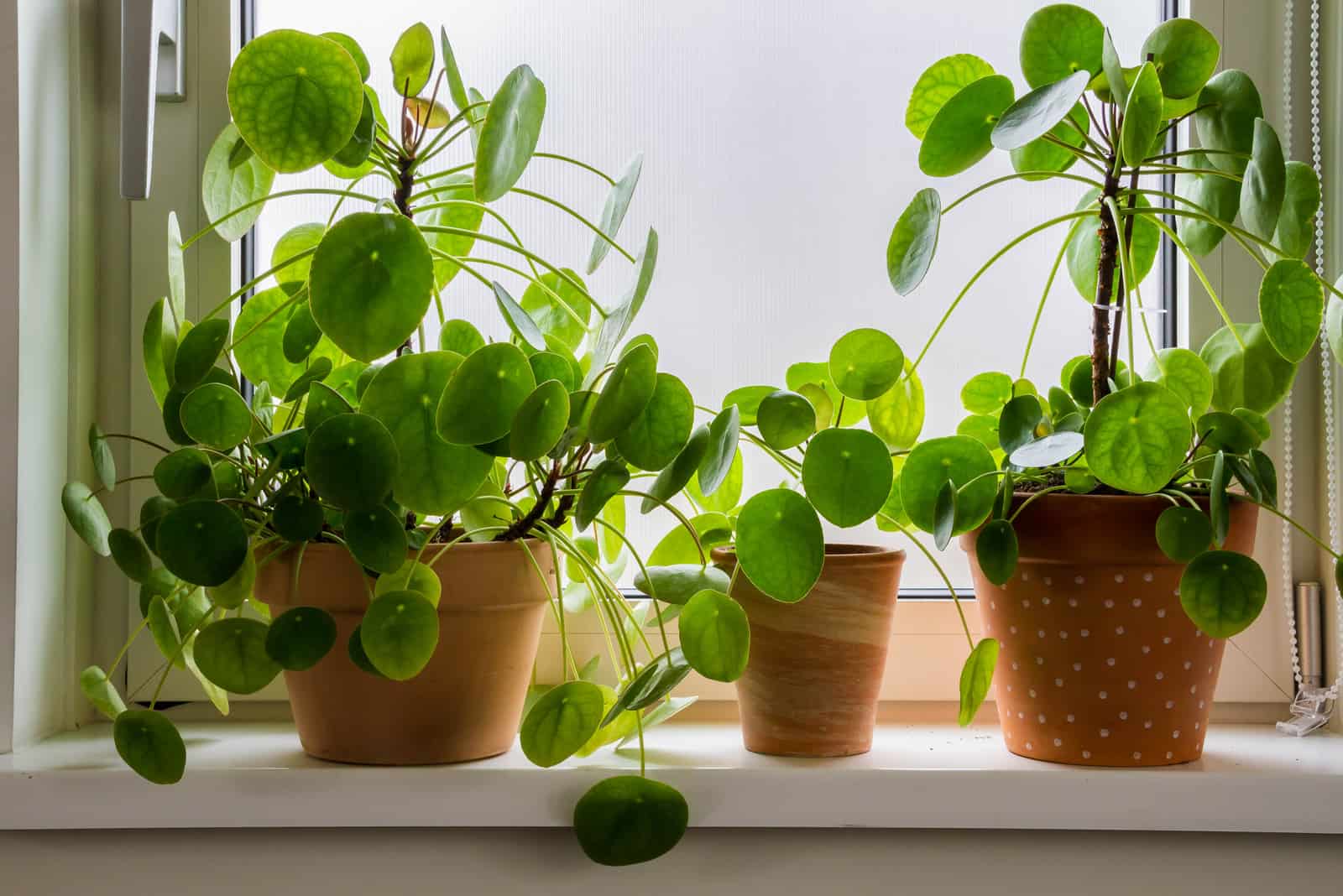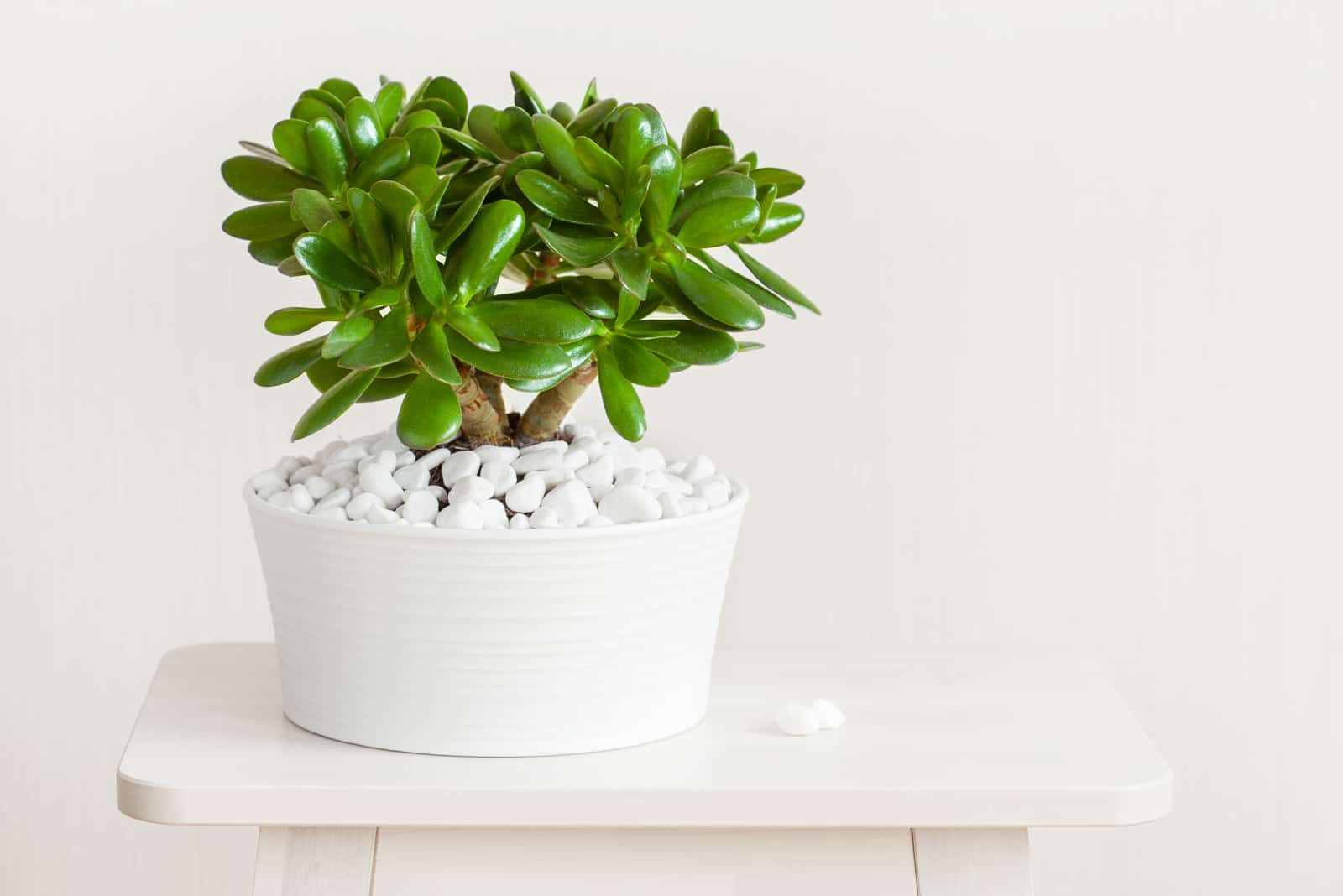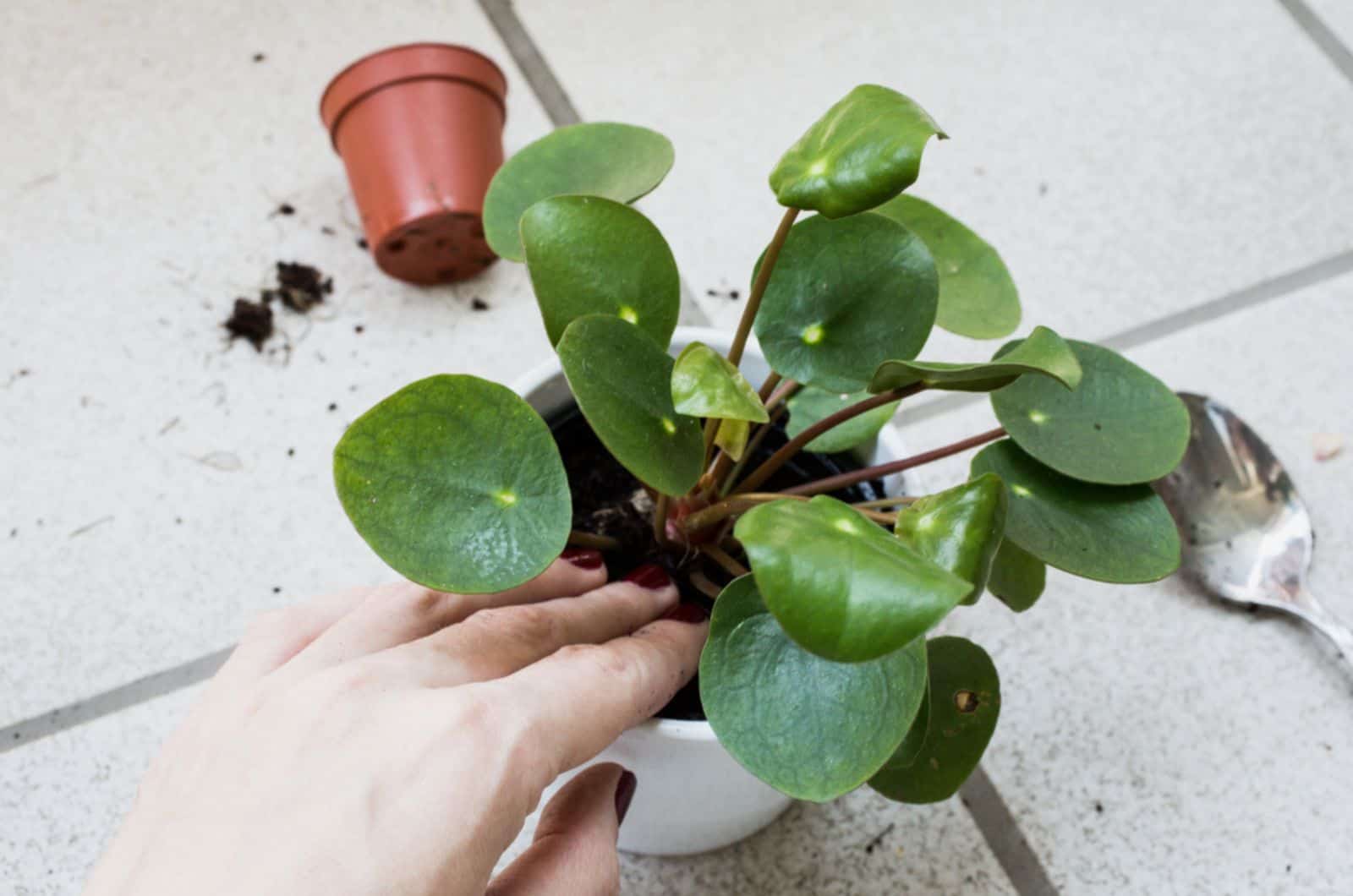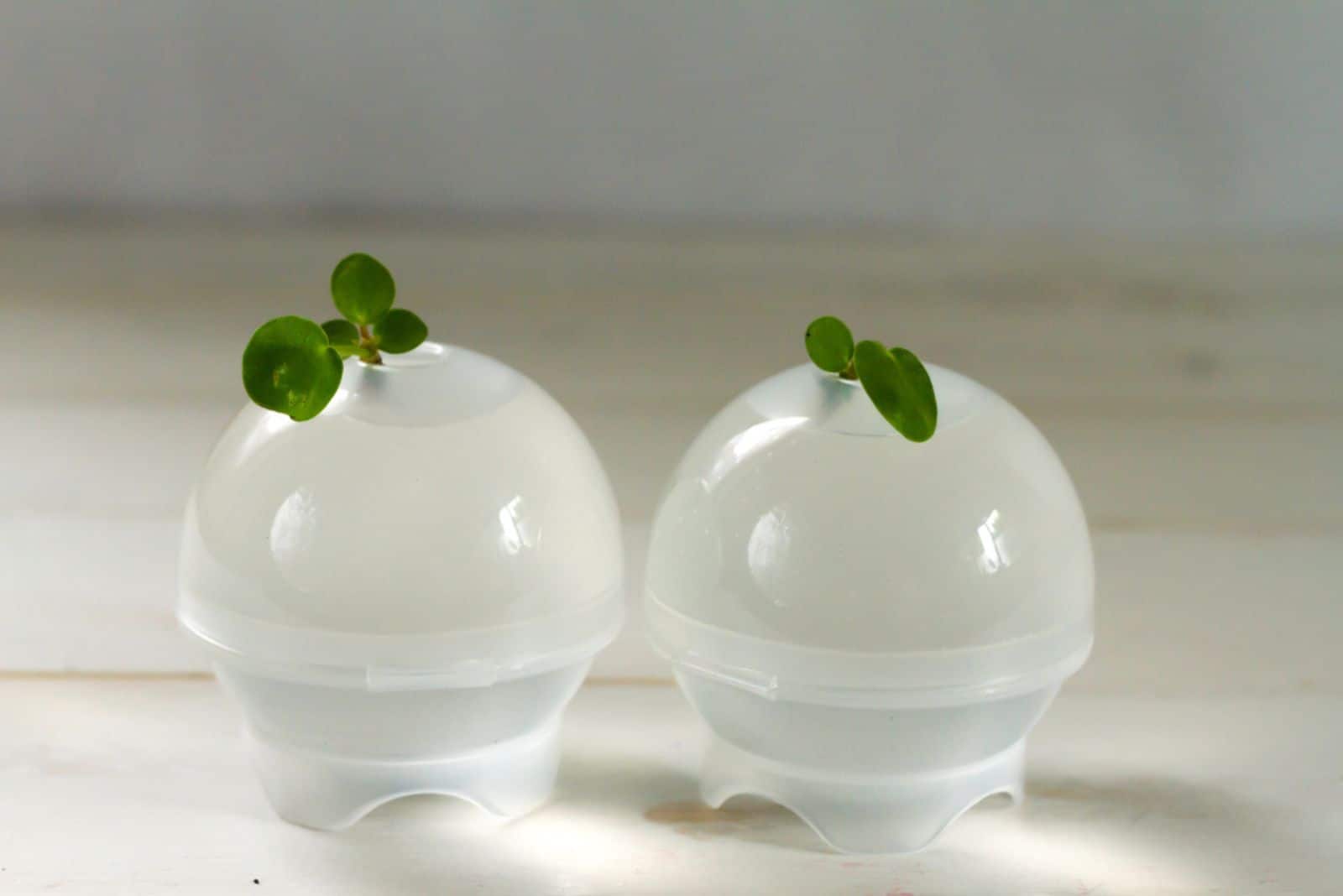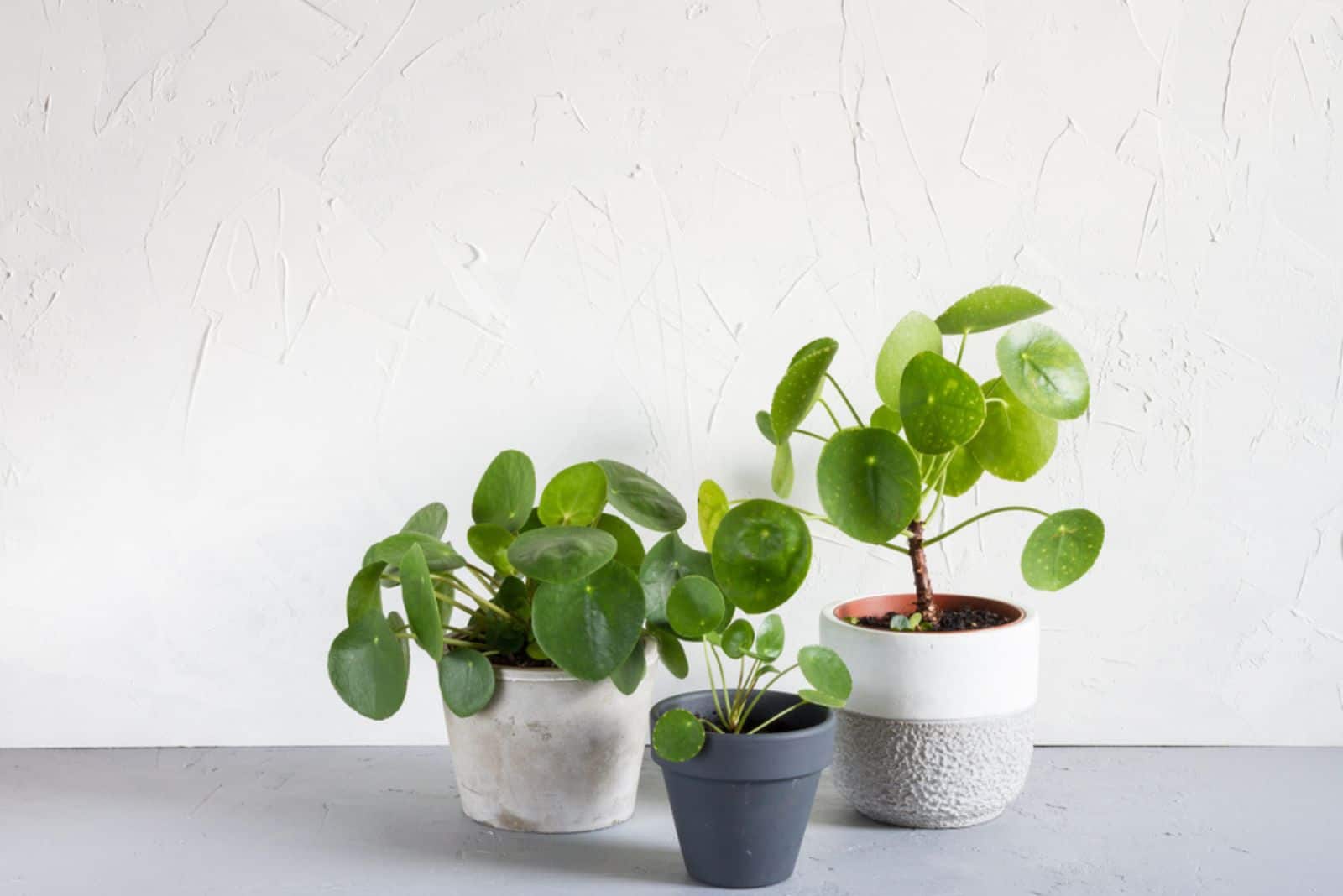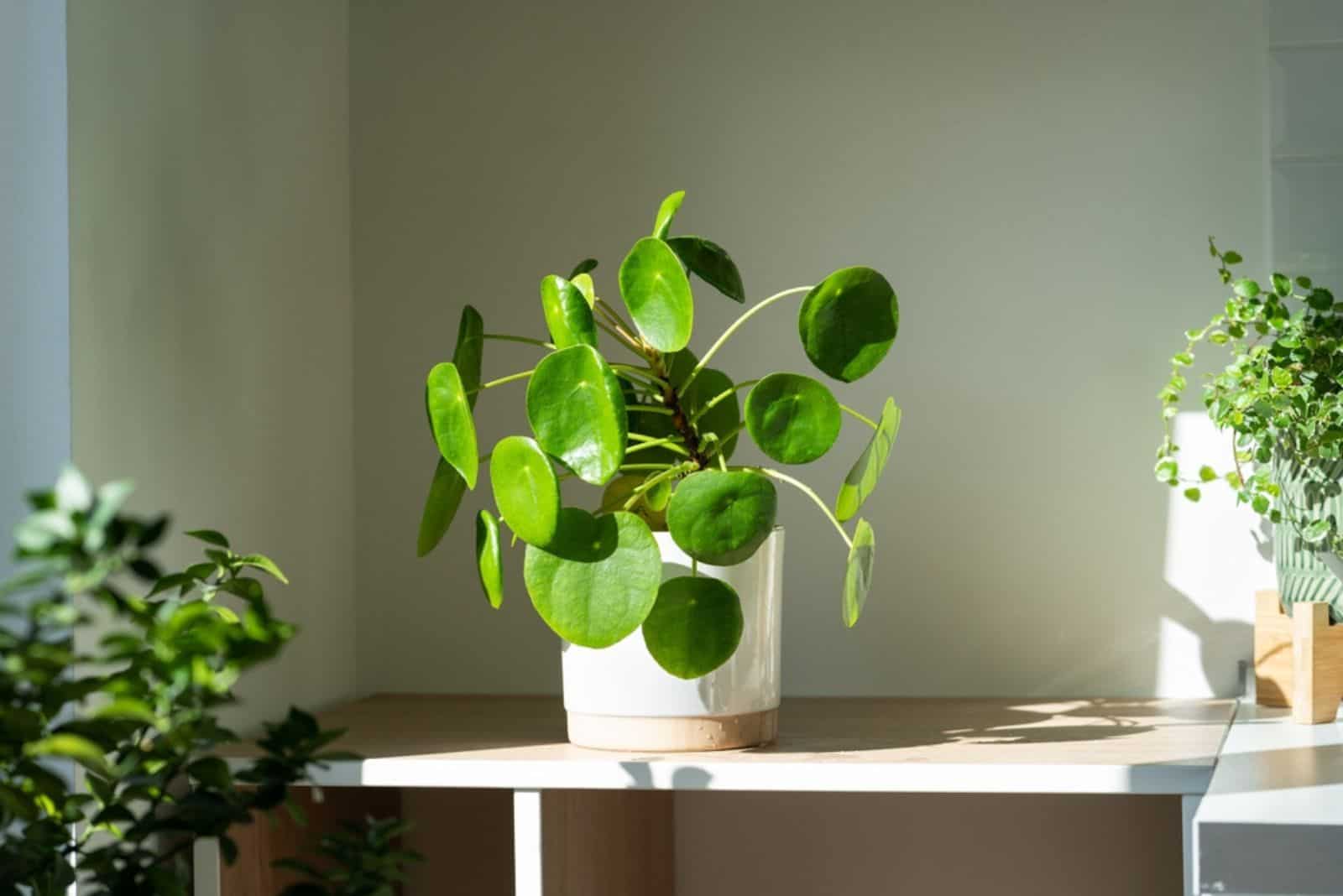Today, we are going to talk about a popular houseplant that can attract good fortune and prosperity — the Chinese Money plant (it doesn’t have “money” in its name for no reason!).
This lovely Peperomia variety, scientific name Pilea Peperomioides, is native to the Yunnan Province in Southern China, but is now commonly found in many households all over the globe. It was first cultivated mostly in Scandinavia, but it quickly gained popularity and spread all across Europe and other continents.
This is the reason this plant has so many names!
Some of the common names include the Pancake plant, Friendship plant, Lefse plant, UFO plant, Scandinavian plant, and Norwegian Missionary plant.
As well as their symbolism, these plants are also grown due to their unique appearance and easy plant care. Keep reading to learn everything you need to know about Chinese Money plant care.
Chinese Money Plant Care Guide
The Pilea Peperomioides is not so different from other houseplants. Generally speaking, they are pretty much low-maintenance plants — though you should be careful when watering.
Propagating these plants is easy peasy, which is why it is ideal for all the beginner growers out there!
Now, let’s dive into plant care.
Water Requirements
Watering these Pancakes might be very tricky — it’s hard to make a strict watering schedule that you can follow because each plant has different watering needs. This is because they are affected by other factors like humidity, temperature, and light.
You will have to water them more frequently during the hot summer days because the soil dries out quicker.
However, there are a few tips and tricks that you can use to determine whether your plant needs to be watered. Firstly, you should always check the soil before watering. You should water the plant if the top one or two inches of the soil have dried out. I would advise you to put off watering for a few days if the soil still seems a little moist.
Don’t water the plants too often as it might lead to overwatering. Overwatering is often accompanied by root rot, which is a fungal disease that can completely ruin your lucky plant. Yellow leaves are also indicators that the plant has been overwatered. You can simply trim off these older leaves around the base of the plant.
This is why it is also crucial to provide proper drainage — adequate potting soil (we will get to that in a minute) and pots with drainage holes in the bottom. These drainage holes help to drain excess water from the soil.
Terracotta and ceramic pots are ideal for these kinds of plants, mainly because they are porous and assist in the evaporation of moisture.
Please note that underwatering is also as important as overwatering. If you don’t keep the soil moist, or let the plant go without water for a long period of time, then your Chinese Money plant can droop and wilt.
In this case, you might also have to repot the plant in a new pot and soil because the soil can get too compact, and it won’t be able to absorb nutrients and water normally. Therefore, the necessary moisture and nutrients won’t even be able to reach the plant’s root system.
Soil Requirements
Good drainage is also acquired by using the right soil type. As the plant requires moist soil, the ideal potting mix would be well-draining soil that’s porous and rich in nutrients.
You have the option of using pre-made or homemade succulent potting mix. You should amend your potting soil with perlite, peat moss, or sand and gravel. The pH levels of the soil should be between 6 and 7.
Light Requirements
The best plant care for any type of plant is mimicking the plant’s natural habitat. These plants can be grown as indoor plants, which makes controlling light exposure easier.
Let’s start by saying that the Chinese Money plant thrives in bright indirect light.
Avoid putting the plant in a location where it is exposed to direct sun — direct sunlight can damage those lovely coin-shaped leaves. Instead, choose a windowsill where they can get enough bright light throughout the day.
I would recommend you put the plant on an east or south-facing windowsill, and rotate the plant so that every side can get enough light.
If you have trouble finding the perfect spot for your plant, you can always invest in grow lights.
Humidity Requirements
These plants can grow perfectly fine in moderate humidity levels. At humidity levels over 50%, they will flourish. There are numerous techniques to increase humidity if you reside in an area with a dry climate.
You can buy a humidifier, make a pebble tray, or try misting your plant every day. Please note that misting early in the day is recommended so as to allow time for the water to evaporate.
If the leaves are always damp, fungi may grow and the green leaves may begin to turn yellow.
In case the humidity levels are too low, the edges of the leaves will look crispy and brown. This is a sign that you should do something about the humidity levels around the plant.
Temperature Requirements
Cold drafts and sudden temperature changes might leave your plant limp and unappealing. This plant does not do well in cold temperatures because it puts it into a state of shock, which makes the entire plant droop rather than just a few leaves.
Anything below 55°F might cause cold shock in this plant, which prefers temperatures between 60 and 85°F. If you leave your Money plant outside during the summer and then forget to bring it inside when the weather becomes colder, you may notice the shock brought on by abrupt temperature changes.
Therefore, either bring your plants inside on time or don’t bring them inside at all; as long as they get enough light, they won’t mind being kept inside all year.
Keeping them next to heaters, air conditioners, drafty windows, etc., is also not recommended because these places undergo frequent temperature changes.
Another drawback for this humidity-loving plant is that heaters and air conditioners also dry out the air.
Fertilization Requirements
The first thing you should be aware of is that fertilizing should only be done during the growing season because that is when these plants are actively growing and will benefit from the extra nutrients.
You can use all-purpose fertilizers with an NPK formula — nitrogen-rich fertilizers are crucial for vibrant new leaf production. You can also use liquid fertilizer weekly or granular fertilizers monthly.
Whichever fertilizer you choose, make sure to follow the manufacturer’s instructions carefully — they are usually displayed on the packaging.
It’s important not to overfertilize your Money plant as this can lead to chemical and salt build-up in the soil, which prevents the normal functioning of the roots. The first indication of overfertilization is stunted growth and discolored leaves.
Feeding plants while they are dormant increases the chance of salt buildup and overfertilization.
Furthermore, to ensure that the plant has access to nutrients, you should always water them before feeding.
Salts can accumulate in the soil if it is not changed frequently; thus, you should replace the growing medium once a year. However, you can flush it with water if you don’t want to change the soil. Place your indoor plant in a tub (or outside to prevent a mess), and carefully pour water into the soil, letting it drain.
Repotting
The Pilea Peperomioides is a fast grower. This means that the plant should be repotted often. If you notice that the roots have started coming out of the drainage holes and the plant has stopped growing overall, then it is time for repotting.
You will need fresh soil and a pot that is 2 inches bigger than the current one.
Repotting is also tricky because of transplant shock. The veins of your plant’s leaves will begin to become yellow and brown, and will only continue to get drier and darker. Other typical signs of transplant shock include curly and droopy leaves, which might be lethal if your plant is unable to adapt to the new soil.
Tips To Avoid Transplant Shock
When repotting plants, the condition of the roots is one of the first things you need to take into consideration. You should be ready for transplant shock if they are soft and squishy (i.e., if there is some root rot).
In this situation, you should cut off the unhealthy roots, replant your green friend in a new pot and fresh soil, give it plenty of water, and cross your fingers for success!
However, there are several strategies you can use to reduce transplant shock in your plants (including vegetables).
Before transferring your plant to a new pot, you must first ensure that it is adequately hydrated. The plant’s water uptake will be reduced by the relocation, although it won’t be an issue if you have been watering the plant properly before repotting.
Additionally, you must water your Money plant very thoroughly after transplanting. It doesn’t readily overwater because it isn’t a succulent, so don’t worry!
As water won’t evaporate as rapidly, transplanting on a cloudy day or keeping your plants in indirect sunlight might lessen the stress your plant will experience.
Repotting or transplanting your plants or seedlings during the cooler hours of the morning or evening is another great option.
Finally, avoid overly disturbing the roots of your plant because this can interfere with its ability to absorb water. Instead, place the root-bound plant in a pot that is one size larger and add a new growing medium to it.
Pruning
Pruning is not really a crucial step in the Chinese Money plant care guide — I mean, who would want to cut those beautiful round leaves in the first place?
However, you should prune off any damaged or discolored leaves. I would recommend you use a clean knife or pruning shears to prevent the spread of infection. You can also prune off the plant regularly if you want to keep a bushier appearance.
Propagation
One of the reasons these plants are so popular is their straightforward propagation. You can get a new plant in no time!
This is because the Chinese Money plant produces plantlets that can be used to grow new baby plants. These plantlets need to grow around 5 to 7 cm long before being cut away from the mother plant.
Detached platelets, aka baby plants, can simply be put in a new pot with fresh soil. Keep the soil moist and add some fertilizers to boost growth. Soon, you will have to repot your new plant into a larger pot!
Read also: A Detailed Guide To Plant Propagation Methods
Common Issues
Just like any other plant, the Chinese money plant can also run into some issues. This plant is susceptible to pests and diseases — however, if you keep your plant happy and healthy, it is highly unlikely that it will end up with a pest infestation.
Now, let’s look at some of these common issues.
Pest Infestations
Follow the care instructions for this plant religiously because unhealthy or stressed plants are more prone to being attacked by pests.
It can help you avoid a lot of hassle!
It is typical to find swarms and colonies of spider mites, aphids, mealy bugs, thrips, and fungus gnats feeding on your plant because this plant is not pest-resistant.
Some pests consume the sap, depriving it of the liquids necessary for proper growth. Your plant doesn’t have enough nutrients or moisture to grow correctly, which causes its brittle stems to droop beneath the weight of the leaves.
Fortunately, getting rid of these annoyances isn’t that challenging. When you spot even one bug, the first thing you should do is separate the infected plant from the healthy ones.
If the infestation isn’t too bad, you can then either pluck the insects off one by one or use a cotton swab dipped in rubbing alcohol to get rid of them.
You can also simply set the plant under a stream of water if some groupings have already formed and you wish to get rid of the pests naturally. Avoid letting the water flow too quickly to prevent damaging your plant.
Using horticultural oils like neem oil to get rid of pests is another great organic option.
However, if nothing appears to be working, you can call in the big guns and use pesticides, which will destroy these pests in no time!
Discolored Leaves
We mentioned that the leaves will start turning yellow if you have been giving your plant too much water. Brown leaf tips and crispy leaf edges are indicators that the plant either isn’t getting enough water or that the humidity is high.
If the leaves are turning completely crispy, then they might get sunburned. In this case, change the location or light conditions.
Leaves might become droopy due to nutrient deficiency, which is why giving them some plant food during the growing season is important.
More About The Chinese Money Plant
Now that we have covered plant care, let’s talk about the plant’s common features and their unique symbolism.
You should also know that this is one of the plants that are able to grow in water.
These plants are also not toxic, which is rare because most houseplants, especially Monsteras, are toxic to pets and humans. What’s also great about these plants is that they are able to purify the air — so, instead of buying an air freshener, simply spend your money on a Chinese Money plant instead.
Growing A Chinese Money Plant In Water
It’s really simple to grow a money plant in water; just place it in a mason jar (or another container of your choice), add some water and fertilizer, and expose it to bright light.
And even though it can stand alone as the centerpiece, this arrangement will complement succulents in a terrarium wonderfully.
Furthermore, it requires substantially less effort because you only need to feed and water your money plant once a month (or when the water level has significantly dropped). However, you will still need to clean the container sometimes, especially if it is made of glass.
The fact that you won’t need to stress the plant after propagation is another wonderful benefit of growing money plants in water.
If you’ve put a cutting in water to propagate it, for instance, you can just leave it there after you see new leaves budding. The new plant will already have water roots established, so it won’t experience the transplant shock that results from being placed in soil.
Appearance
The Pancake plant is an attractive, tiny plant with gorgeous, round, coin-shaped green leaves. It truly seems as though your pocket money is sprouting from a tree! It has charmed a lot of people and recently gained a lot of attention on social media.
As well as their unique-looking leaves, the Chinese Money plant also produces white flowers on pink stems once the temperature cools down.
How To Get A Chinese Money Plant To Bloom
Occasionally, mature pancake plants will bloom with the tiniest of blooms on stalks that extend from the plant’s base. Surprisingly, these flowers are not very appealing, and many growers simply trim them off — only the ones who wish to experiment with seed propagation encourage flowering.
Try relocating your pancake plant to a colder room for the winter if you want it to bloom. Sometimes a plant will produce blossoms as a form of self-propagation after a mild shock to the system. A plant that is happily flourishing in optimal circumstances rarely experiences this.
Symbolism
The name “Missionary plant” was given to this plant because Agnar Espegren, a Norwegian missionary, took a cutting of this plant home with him. This happened in the 1940s, and since then the plant has spread across Scandinavia. Nowadays, it can be found in many households.
It’s said that a Money plant would fill your home with a lot of serenity and peace. This is what makes it a magical indoor plant that has the ability to fix every problem in your home. According to Feng shui for money plants, this plant is thought to spread a lot of goodness and positivity. It can also attract good fortune and prosperity!
To Sum Up
After our detailed Chinese Money Plant care guide, we can conclude that these plants are relatively easy to take care of. All you have to do is be extremely careful when it comes to watering and repotting.
If you don’t want to deal with that altogether, then you can try and grow your Chinese money plant in water.
If you are interested in adding this lovely plant to your plant collection, you can easily find them online, though I’m sure that most local nurseries or garden centers have them too.
So, try your luck and grow a Chinese Money plant in your room. It will definitely make it look more lively, and also attract some positive vibes!
I hope this article was helpful.
Until next time!
Like this post? Share or pin it for later!

